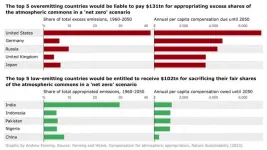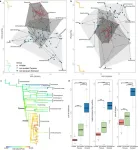(Press-News.org) Fungi stores a third of carbon from fossil fuel emissions and could be essential to reaching net zero, new study reveals
Mycorrhizal fungi are responsible for holding up to 36 per cent of yearly global fossil fuel emissions below ground - more than China emits each year
The fungi make up a vast underground network all over the planet underneath grasslands and forests, as well as roads, gardens, and houses on every continent on Earth
It is not only crucial to storing carbon and keeping the planet cooler, but are also essential to global biodiversity
Researchers are now calling for fungi to be considered more heavily in conservation and biodiversity policies, and are investigating whether we can increase how much carbon the soil underneath us can hold
The vast underground network of fungi beneath our feet stores over 13 gigatons of carbon around the world, roughly equivalent to 36 per cent of yearly global fossil fuel emissions, according to new research.
It is widely believed that mycorrhizal fungi could store carbon, as the fungi forms symbiotic relationships with almost all land plants and transports carbon, converted into sugars and fats by the plant, into soil, but until now the true extent of just how much carbon the fungi were storing wasn’t known.
The discovery by a team of scientists, including researchers from the University of Sheffield, that fungi is storing over a third of the carbon created from fossil fuel emissions each year indicates that it could be crucial as nations seek to tackle climate change and reach net zero. Work is now being undertaken to see whether we could increase how much carbon the soil underneath us can store.
Mycorrhizal fungi have been supporting life on land for at least 450 million years and make up vast underground networks all around us - even forming beneath roads, gardens, and houses, on every continent on Earth.
The international team of scientists, including experts from the University of Sheffield’s School of Biosciences, conducted a meta-analysis of hundreds of studies looking at plant-soil processes to understand how much carbon is being stored by the fungi on a global scale.
Their findings, published in Current Biology, revealed that an estimated 13.12 gigatons of CO2 is transferred from plants to the fungi annually, transforming the soil beneath our feet to a massive carbon pool and the most effective carbon capture storage unit in the world.
The amount of carbon stored equates to roughly 36 per cent of yearly global fossil fuel emissions - more than China emits each year.
Researchers are now calling for fungi to be considered in biodiversity and conservation policies, given its crucial role in cutting carbon emissions. At the current rate, the UN warns that 90 per cent of soils could be degraded by 2050, which could be catastrophic for not only curbing climate change and rising temperatures, but for the productivity of crops and plants too.
Professor Katie Field, Professor of Plant-Soil Processes at the University of Sheffield and co-author of the study, said: “Mycorrhizal fungi represent a blind spot in carbon modelling, conservation, and restoration - the numbers we’ve uncovered are jaw-dropping, and when we’re thinking about solutions for climate we should also be thinking about what we can harness that exists already.
“Soil ecosystems are being destroyed at an alarming rate through agriculture, development and other industry, but the wider impacts of disruption of soil communities are poorly understood. When we disrupt the ancient life support systems in the soil, we sabotage our efforts to limit global heating and undermine the ecosystems on which we depend.
“More needs to be done to protect these underground networks - we already knew that they were essential for biodiversity, and now we have even more evidence that they are crucial to the health of our planet.”
The researchers are now investigating how long the carbon is stored by the fungi in the soil, and are seeking to further explore the role that fungi plays in Earth’s ecosystems.
Dr Heidi Hawkins, lead author of the study from the University of Cape Town, said: “We always suspected that we may have been overlooking a major carbon pool. Understandably, much focus has been placed on protecting and restoring forests as a natural way to mitigate climate change, but little attention has been paid to the fate of the vast amounts of carbon dioxide that are moved from the atmosphere during photosynthesis by those plants and sent belowground to mycorrhizal fungi.
“A major gap in our knowledge is the permanence of carbon within mycorrhizal structures. We do know that it is a flux, with some being retained in mycorrhizal structures while the fungus lives, and even after it dies. Some will be decomposed into small carbon molecules and from there either bind to particles in the soil, or even be reused by plants. And certainly, some carbon will be lost as carbon dioxide gas during respiration by other microbes or the fungus itself.”
Professor Toby Kiers, senior author from Vrije University Amsterdam and co-founder of the Society for the Protection of Underground Networks, said: “The paper is part of a global push to understand the role that fungi play in Earth’s ecosystems. We know that mycorrhizal fungi are vitally important ecosystem engineers, but they are invisible to most people.
“Mycorrhizal fungi lie at the base of the food webs that support much of life on Earth, but we are just starting to understand how they actually work. There’s still so much to learn.”
One of the projects which is now investigating the role of mycorrhizal fungi in soil carbon and other nutrient cycles in more detail is being led by the University of Sheffield’s School of Biosciences. Using simulated future climates in specialised outdoor field experiments, the NERC-funded study aims to improve our understanding of the critical role of soil fungi, alongside other microbes, in moving carbon belowground and how this will be impacted by future climate change.
END
Fungi stores a third of carbon from fossil fuel emissions and could be essential to reaching net zero, new study reveals
Researchers are now calling for fungi to be considered more heavily in conservation and biodiversity policies, and are investigating whether we can increase how much carbon the soil underneath us can hold
2023-06-05
ELSE PRESS RELEASES FROM THIS DATE:
Climate justice: Global North owes $170 trillion for excessive CO2 emissions, says study
2023-06-05
Industrialised nations responsible for excessive levels of carbon dioxide emissions could be liable to pay a total of $170 trillion in compensation or reparations by 2050 to ensure climate change targets are met, say researchers.
This money, which amounts to nearly $6 trillion per year or about 7% of annual global Gross Domestic Product (GDP), would be distributed as compensation to low-emitting countries that must decarbonise their economies far more rapidly than would otherwise be required.
Financial redress for the losses and damages that climate-vulnerable countries face due to the excessive CO2 emissions of others is seen as an increasingly important ...
BRIDGEcereal: Self-teaching web app improves speed, accuracy of classifying DNA variations among cereal varieties
2023-06-05
Kim Kaplan
301-588-5314
Kim.Kaplan@usda.gov
BRIDGEcereal: Self-Teaching Web App Improves Speed, Accuracy of Classifying DNA Variations Among Cereal Varieties
PULLMAN, WA, June 5, 2023—Agricultural Research Service and Washington State University scientists have developed an innovative web app called BRIDGEcereal [https://bridgecereal.scinet.usda.gov/] that can quickly and accurately analyze the vast amount of genomic data now available for cereal crops and organize the material into intuitive charts that identify patterns locating genes of interest.
With the rapid advancements in ...
Availability of LGBTQ mental health services for youth
2023-06-05
About The Study: This survey study found that 28% of youth-serving U.S. mental health facilities offered LGBTQ-specific mental health services in 2020. Although some states had relatively high levels of LGBTQ service availability as a percentage of facilities, many of these states had few facilities available to children per capita. Public mental health facilities were less likely to offer LGBTQ-specific mental health services, a concern given that the cost of care is a barrier to services. The findings suggest a need to expand availability of LGBTQ services ...
Can exercise help counteract genetic risk of disease?
2023-06-05
New research has revealed being active could lower the risk of type 2 diabetes, even in people with a high genetic risk of developing the medical condition.
The University of Sydney-led study found higher levels of total physical activity, especially moderate- to vigorous-intensity physical activity, had a strong association with a lower risk of developing type 2 diabetes.
The findings were published in the British Journal of Sports Medicine.
The researchers say the study demonstrates higher levels of physical activity should be promoted as a major strategy for type 2 diabetes ...
DNA sequencing in newborns reveals years of actionable findings for infants and families
2023-06-05
Researchers who lead the world’s first comprehensive sequencing program for newborn infants have published the next chapter in the ongoing study of the BabySeq Project, with new findings on infants and families who have been followed for 3-5 years. In a study published today in the American Journal of Human Genetics, researchers from Mass General Brigham and Boston Children’s Hospital reported that over 10 percent of the first 159 infants to undergo screening through DNA sequencing were discovered ...
Tirzepatide has unique activity to stimulate insulin secretion
2023-06-05
DURHAM, N.C. – Tirzepatide, a drug approved for diabetes and on the fast track for approval as a weight loss therapy, works through a unique ability to activate two different mechanisms the body uses to control insulin secretion and energy balance, Duke Health researchers report.
The finding, reported June 5 in the journal Nature Metabolism, is the first study to use cells from human donors to demonstrate how tirzepatide stimulates insulin secretion, an important action utilized by this drug to lower blood glucose in patients with type 2 diabetes.
“Understanding the potential of drugs ...
ASCO: Axi-cel significantly improves survival in patients with early relapsed or refractory large B-cell lymphoma
2023-06-05
CHICAGO – Patients with early relapsed or refractory large B-cell lymphoma had significantly improved overall survival when treated with the chimeric antigen receptor (CAR) T cell therapy axicabtagene ciloleucel (axi-cel) when compared to the current standard-of-care chemoimmunotherapy, according to results of the Phase III ZUMA-7 trial reported by researchers from The University of Texas MD Anderson Cancer Center.
Data from the study were presented today by Jason Westin, M.D., director of clinical research in the Department of Lymphoma and Myeloma, at the 2023 American Society of Clinical Oncology (ASCO) Annual Meeting and published concurrently in ...
Doctors test chest pain medication to treat hot flashes
2023-06-05
Women have long searched for remedies for the bothersome hot flashes that often come with menopause.
In a novel investigation, researchers at UC San Francisco tested the benefits of continuously wearing a nitroglycerin patch – an established treatment for chest pain from coronary artery disease – for menopausal women experiencing at least seven hot flashes a day. Unlike most treatments for hot flashes that target brain mechanisms, nitroglycerin works on blood vessels throughout the body.
The results were mixed. While ...
Scientists expand understanding of limb evolution in earliest birds
2023-06-05
The assembly of the volant bird body plan from the ancestral bulky dinosaurian condition is an enduring topic of evolutionary biology. The body plan of volant birds demonstrates a pronounced decrease in body size and proportionate elongation of the forelimbs. Given the scaling relationship between limb and body size, changes to the former were likely clouded by changes to the entire body size.
Since changes to individual limb elements provides the direct basis for natural selection, they are essential to comprehending branch- and lineage-specific evolutionary patterns across the transition from terrestrial to ...
Tracing Chile’s indigenous roots through genetics and linguistics
2023-06-05
How do today’s indigenous communities of South America trace back to the history of human migration and contact in the continent? An international team has worked to reconstruct the legacy of Chile’s largest indigenous community, the Mapuche, in a quest to strengthen their representation in the history of the continent. It appears the Mapuche long lived in relative isolation but do bear some influences from other populations of the Central Andes and the far south of Chile.
South America was the last continent ...
LAST 30 PRESS RELEASES:
Bulk inorganic crystals grown from water emit “handed” light
A new AI-based attack framework advances multi-agent reinforcement learning by amplifying vulnerability and bypassing defenses
While exploring the cosmos, astronauts also fuel explorations of the biology of aging and cellular resilience
Design and synthesis of Zr-IR825 nanoparticles for photothermal therapy of tumor cells
Food critics or food grabbers? When choosing food, wood mice split into careful examiners who sniff and handle, and quick nut grabbers
‘Cosmic clock’ reveals Australian landscapes’ history and potential future
Higher maternal blood pressure increases the risk of pregnancy complications, study concludes
Postoperative complications of medical tourism may cost NHS up to £20,000/patient
Phone apps nearly 3 times as good as no/basic support for quitting smoking long term
Female sex and higher education linked to escalating prevalence of obesity and overweight in Africa
THE LANCET + eCLINICALMEDICINE: Two studies on reductions in mortality from small changes lifestyle changes
AI model identifies how every country can improve its cancer outcomes
Young people risk drifting into serious online offenses through a slippery slope of high-risk digital behavior
Implant provides lasting relief for treatment-resistant depression
Autologous T cell therapy targeting multiple antigens shows promise treating pancreatic cancer
First extensive study into marsupial gut microbiomes reveals new microbial species and antimicrobial resistance
Study debunks myth of native Hawaiians causing bird extinctions
Tailored biochar could transform how crops grow, resist disease, and clean polluted soils
Biochar-based enzyme technology offers new path for cleaner water and soil
Biochar helps farmland soils withstand extreme rain and drought by steadying carbon loss
New study reveals major gaps in global forest maps
Ochsner Health names Dr. Timothy Riddell executive vice president and chief operating officer
Can future-focused thoughts help smokers quit?
From brain scans to alloys: Teaching AI to make sense of complex research data
Stem Cell Reports seeks early career editors to join the editorial board
Signs of ancient life turn up in an unexpected place
Pennington Biomedical researchers explore factors behind body’s ability to regulate weight
Zhongping Lee awarded the Nils Gunnar Jerlov Medal
Deborah S. Kelley awarded the Wallace S. Broecker Medal
Novel immunotherapy demonstrates early potential to overcome resistance to immune checkpoint therapy
[Press-News.org] Fungi stores a third of carbon from fossil fuel emissions and could be essential to reaching net zero, new study revealsResearchers are now calling for fungi to be considered more heavily in conservation and biodiversity policies, and are investigating whether we can increase how much carbon the soil underneath us can hold




